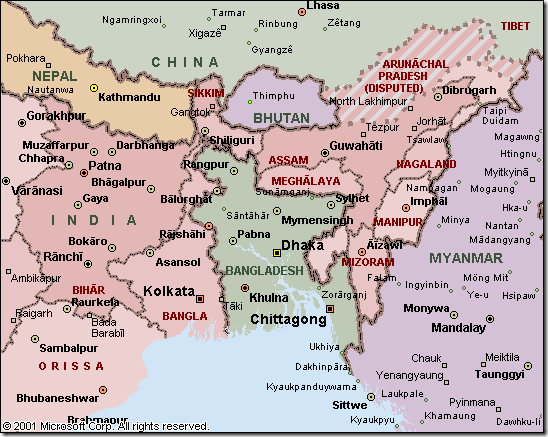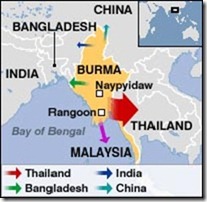By Ashfaqur Rahman

Now that we have agreed in principle to allow a shorter road passage for Indians to reach North East India through Bangladesh, let us see how we are likely to also benefit.
* As things stand, it will be a small fee that we can expect from the Indian vehicles that will pass through;
* We will enjoy greater connectivity with a part of India which has been closed to the world for practical purposes for so long;
* We hope for more trade between Bangladesh and the states of North East India;
* We look forward to invest in North East India. This could be to produce goods and services for the people of that region;
* We hope to be able to travel to some of the beautiful spots in this extraordinary part of India. We would get to know the various tribes, their languages, their customs, their cultures and their ways of life.
In turn, the people of North East India would travel to Bangladesh. They would also trade with us, perhaps invest here. But the important thing for them would be that they will be able to bring goods from mainland India to the north eastern states at reasonable cost.
They would also move to the Indian states west of Bangladesh at low cost. Finally, they may use our transports to move their exports and imports using Bangladeshi ports. Thus, they would be able to save time, energy and costs.
So, as a good neighbour to North East India we can look forward to a better morrow. But before we count the blessings, let us look closely at the North East Indian states.
The first thing to know is that North East India is not a homogenous area. It is not a single geographical whole. The mountains and the valleys separate regions and peoples. The people also do not necessarily share a common heritage.
Due to geographical isolation of the area as well as its "burden of history," particularly its economic severance from the rest of India at the time of Partition (1947), there is poverty and therefore discontent among the people. Whatever communication links it had with Bangladesh (formerly East Pakistan) were also snapped during the 1965 war between India and Pakistan.
The North Eastern states of India border China, Myanmar, Bhutan and Bangladesh, and cover a total area of 255,000 sq km. Before the British came to India, these states were integrated politically and economically with the rest of the sub-continent. Hence "North East" as a concept only emerged after India became a colony of the British.
But this happened over a period. The British first established their rule over Assam in
1826. In 1830, they took Cachar. The Khasi Hills came under their control in 1883. The Naga hills in 1885, the Garo Hills in 1872 and the Lushai Hills in 1890.
In 1947, when India became independent, the region was tenuously connected with the rest of India by a 21 km wide Siliguri corridor. Thus, less than 1% of the external boundaries of these states remain contiguous with the rest of India. The rest 99% of these states have international borders.
It is curious to note that the nationalist struggle for a Free India did not touch the people of the North East. As one Indian scholar has noted, they "remained immune to the process of Indianness."
The North Eastern States of India are endowed with abundant natural resources. There are oil reserves, stones, tropical forests, hydro-electricity, tea, coal, timber, rubber, fruits, silk and jute.
But due to high population growth, labour immobility, restricted land market, a disturbed political and social environment and a subsistence economy, development did not take place.
There are eight states in the North East of India. They are Sikkim, Arunachal, Mizoram, Assam, Manipur, Meghalaya, Nagaland and Tripura. In each of the states there are several ethnic groups. There are also many tribes within each ethnic group. Arunachal has 110 tribes, Assam 20, Manipur 2, Meghalaya 3, etc. So in spite of formation of each of these states based on ethnic and tribal identities, the entire area is heterogeneous. Violence and insurgencies persist in these heavenly abodes.
So how should Bangladesh proceed to connect trade and invest and start tourism with this neighbouring region?
To begin with, and as mentioned, we must not consider North East as a single, homogenous area. We, therefore, should not craft a single set of policies to serve the entire region.
We need to carefully study each of the territories, the tribes, their ethnic build up, their existing resources, their potentials as well as their tribal rivalries. We should then devise policies in such a way that we are able to adopt pragmatic approaches while interacting with individual states. We need to advise the private sector of Bangladesh to move cautiously, in collaboration with the state governments and the local Chambers of Commerce as well as our government agencies, into these areas.
We must not be overly ambitious and go for big projects or industries at the initial stage. We should proceed incrementally and see what succeeds. Then we can move on to bigger projects. Each state may or may not even have laws in place to protect foreign investments. We suggest that India may also think initially of setting up a Special Economic Zone for Bangladeshi entrepreneurs in the state of Tripura, where we can park our investments.
But before that starts both the governments need to work on "trade facilitation" measures. Local infrastructure must be upgraded both on the Bangladeshi side and in each North Indian state. Border customs and currency exchange systems must be established, non- tariff barriers removed and, for ease of movement of Bangladeshi entrepreneurs, visa procedures simplified. Standards for goods and services also need to be "harmonised" between the two countries as well within the Indian states.
Bangladesh needs to set up consular posts in the region. At present there is one consular outpost in Agartala, Tripura. We could consider setting another one soon in Assam. These posts should also disseminate information about Bangladesh. India may not insist that these offices have to be set up on a reciprocal basis.
Thus, putting the right policies in place will usher in an era of peaceful engagement between the people of the two regions. It is time we work on the basis of a vision that conjures prosperity for the teeming millions in this part of South Asia.
The writer is a former Ambassador and Chairman of the Centre for Foreign Affairs Studies.
E-mail: ashfaq303@hotmail.com














